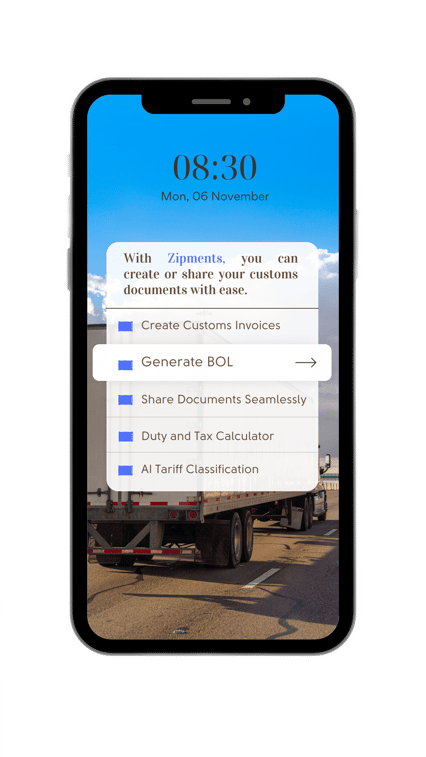The freight shipping process is like a complex piece of machinery: There are many moving parts, and...
How To Avoid Bill of Lading Mistakes and Generate BOLs Effortlessly With Technology
A well-completed Bill of Lading is a priceless asset for shippers. As a crucial document that ensures smooth sailing for all shipments and minimizes delays; it's essential to understand the intricacies involved in creating a Bill of Lading correctly. Creating a BOL may seem straightforward, but the devil lies in the details. By understanding the common pitfalls to avoid when generating a Bill of Lading, you can optimize your shipment process and maximize efficiency. Better yet, you can also learn how to generate your next BOL seamlessly, with the right technology.
.png?width=1920&height=1080&name=Grey%20Modern%20Professional%20Business%20Project%20Presentation%20(2).png)
Bill of Lading Definition
A Bill of Lading is one of the most important documents you will need in shipping, as it contains all the essential information needed to move goods from point A to point B seamlessly. The Bill of Lading serves as a crucial document that not only ensures the safe and timely delivery of goods but also provides legal protection as a proof of ownership. Shippers, carriers and freight forwarders are usually the three parties involved in the creation of this document.
The purpose of a BOL is to act as a contract between shippers and carriers, act as a title document, and serve as a receipt for services. The document contains critical information that is needed for carriers and drivers to do their job correctly, and to invoice a shipment correctly. It can serve many purposes, but the main three are quite significant:
- It outlines ownership of the goods, thus can act as a title document. This is essential when ownership transfers during the transit process.
- The document acts as a receipt for the shipment. The carrier signs the BOL at pickup to acknowledge that the goods have been received in good condition.
- A BOL is a contract between carrier and shipper. It is a legally binding document that outlines terms or conditions under which a shipment will move from point A to point B.
A Bill of Lading needs to be provided to the carrier when freight is picked up, and a copy of it needs to also be attached to the shipment itself. Some of the essential information you may find on a BOL includes:
- Name and address of consignee or consignor
- Detailed description of goods
- Terms of contract
- Port of loading/discharge
- The carrier responsible for the goods
- Freight charges
- Special instructions
- The notify party
Most Common Mistakes Made On a Bill of Lading
In a digital age, it should be easier than ever to generate the right Bill of Lading on the first try, but naturally we all need time to adjust. Some shippers and carriers are still working through the kinks of modern ways of generating their paperwork, so there are still things for everyone to look out for. Since the BOL serves as a legal contract, it is important that all information is correct and up to date. Issues that arise from wrong information can lead to legal disputes and delays. Some common errors that are still possible on a BOL, and should be avoided, include:
Wrong address or names of shipper or consignee
The wrong address or contact information can lead to goods ending up in the wrong location or shipping delays while information is gathered.
Vague or no description of items being shipped
If a description of goods is vague or missing entirely, there can be issues with assessing the goods at customs and lead to further delays, fines or other penalties.
Incorrect freight classification
Listing the wrong freight class will not only delay the delivery of goods, but it can lead to penalties and fines with customs, as classification is one of the key ways to assess goods for duties, taxes and admissibility.
Inaccurate dimensions or weight
Carriers need to be able to manage their transport efficiently, while customs needs information to assess goods coming into a country; thus when getting the wrong dimensions or weight, it may throw off the entire operation and lead to discrepancies which need to be fixed, and can become costly.
How To Avoid Mistakes On Your Bill of Lading
Filling out a Bill of Lading incorrectly can lead to complications which include delays and even potentially misplacing or losing goods. Shipping internationally involves a lot of steps and parties, including carriers and consignees, so having a clear outline of responsibilities and ensuring everyone understands their role is essential. It is quite simple to create a BOL without errors, if you account for the necessary information.
Avoiding errors on your BOL can take a few extra steps in your process. It is essential to double check all data against records or other source documents, to ensure that the information on your BOL is correct. You will also want to conduct regular reviews for accuracy and legal compliance. It is also beneficial to consider having a standardized process for managing or generating the document, so that there is less room for error. Regulations change with time, especially internationally, so it is important to ensure that your documents are following up to date rules and requirements.
Leverage Technology
In a digital age, generating a correct Bill of Lading document has become easier than ever. Managing your paperwork manually does leave more room for error and can take up more time. When you use the right platform to generate your Bill of Lading, you can ensure efficiency and ease.
With Zipments, you can bid farewell to cumbersome paperwork and say hello to easy-to-complete forms for your next shipment. Our digital platform offers user-friendly Customs Invoice forms, enabling you to effortlessly generate your Bill of Lading.
✔️Customs Invoices Use AI Technology To Detect HS or Tariff Code
✔️Share Updates and Documents Seamlessly In Minutes
✔️Generate Your Bill of Lading While Creating Your Invoice
Our technology ensures that you never miss any crucial details. No more juggling multiple documents and wasting time compiling paperwork. With Zipments, you can experience a streamlined and stress-free process, allowing you to focus on what you do best – running your business.
Mastering the process of creating a well-completed Bill of Lading is a game-changer for shippers and carriers. Embracing the right technology can streamline and simplify the creation of your next Bill of Lading or Customs Invoice, empowering you to navigate the logistics landscape with confidence and ease. You can simplify your shipping process with Zipments – the perfect technology solution for creating seamless customs documentation. You can save time and money, while improving your shipping process.



.png?height=200&name=Hauling%20Photo%20Business%20Blog%20Banner%20(7).png)
-1.png?height=200&name=Brown%20Simple%20Tips%20Shoot%20Blog%20Banner%20(7)-1.png)
